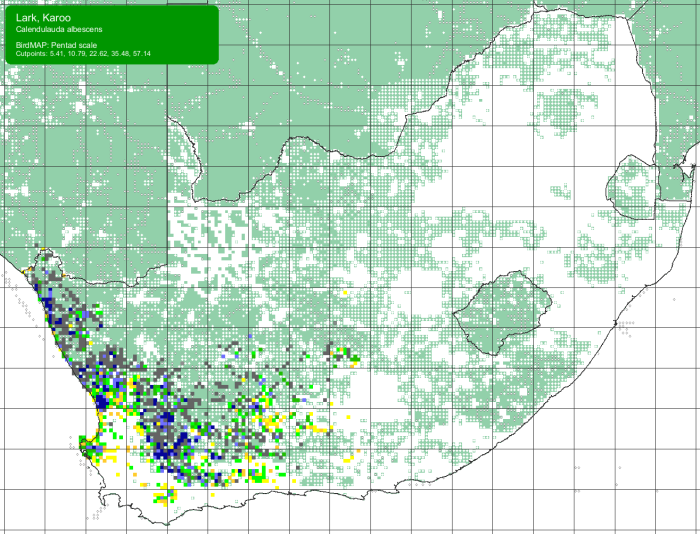Cover image: Karoo Lark by Gerald Wingate – Ceres district, Western Cape – BirdPix No. 217927
Identification
The Karoo Lark is a small, attractive species with a less robust and more delicate build than other similar larks. The bill is relatively slender and somewhat decurved.

Photo by Ryan Tippett
The facial markings are well defined. The supercilium and the line under the eye form a broad white eye-ring with a black stripe through the middle. Black malar and moustachial stripes are prominent and the ear coverts are dark rufous to brown.
Upperpart colouration is highly variable, ranging from pale sandy brown to dark brown, to rich brick red, and with several shades in-between. Despite this variability, the upperparts are normally well streaked. The underparts are white and are strongly marked. The Karoo Lark has streaked flanks which distinguish it from the similar Red Lark and Barlow’s Lark, both of which normally have unmarked flanks.
Males are larger than females but are otherwise alike.
Juveniles have white tips to the feathers on the upperparts, giving them a spotted appearance.

Photo by Karis Daniel
Status and Distribution
The Karoo Lark is a South African endemic. It is restricted to parts of the Northern, Western and Eastern Cape provinces. It is fairly common in the southern and western Karoo as well as in strandveld along the west coast. It is less common in the colder, high elevation shrublands of the central Karoo.

Photo by Zenobia van Dyk
The range of the Karoo Lark has contracted locally in the southern parts of the Western Cape owing to agriculture. The transformation of renosterveld into wheat lands has undoubtedly removed much of its habitat. Karoo Lark populations may be growing in the northeast of its range, due to local increases in shrubs as a result of overgrazing. It is not adequately protected in existing nature reserves and should be a candidate for conservation attention. Despite this the Karoo Lark is not considered to be threatened.

Details for map interpretation can be found here.
Habitat
The Karoo Lark prefers relatively tall, open shrublands on sandy soils. This includes dry coastal fynbos, strandveld and Karroid dwarf-shrublands. It occurs in both the Winter and Summer rainfall regions of the Karoo. In stony regions of the Karoo it is largely restricted to dry watercourses where the substrate is sandier and the vegetation may be taller. The Karoo lark also occurs in sparsely vegetated fallow fields but avoids land being actively farmed. It is less common in short shrublands, for example where heavy grazing has trampled the veld.

Note the sandy soil and presence of taller bushes and shrubs.
Photo by Ryan Tippett
Behaviour
The Karoo Lark may be solitary or found in pairs. It forages on the ground and walks slowly with a hunched posture. Frequently digs with its bill, especially around the base of shrubs. Feeds primarily on seeds, insects and berries. Runs between shrubs in a mouse-like fashion when disturbed, or flies up to perch on a bush.

Photo by J. Terblanche
During display the male sings from the top of a bush or in flight. In display flight the male rises on rapidly beating wings to around 20 m above the ground. The flight is laboured, with slow, deep wing-beats and the tail pointed downwards while calling repeatedly.
The Karoo Lark has an extended breeding season from August to March. It breeds seasonally (August to December) in the Winter rainfall parts of its range and more opportunistically in the central Karoo, which receives erratic Summer rainfall.
The Karoo lark is monogamous and is a territorial, solitary nester. The nest is a cup composed of grass fibres with a domed roof. It is set into a scrape at the base of a plant and is built by both sexes. Clutch size ranges from 2 to 3 eggs but the incubation, nestling and fledging period is unrecorded.

Photo by Maans Booysen
Further Resources
Species text adapted from the first Southern African Bird Atlas Project (SABAP1), 1997.
The use of photographs by Gerald Wingate, J. Terblanche, Karis Daniel, Maans Booysen, Marna Buys and Zenobia van Dyk is acknowledged.
Virtual Museum (BirdPix > Search VM > By Scientific or Common Name).
Other common names: Mirafra albescens; Certhilauda albescens (Alternative Scientific Names); Karoolewerik (Afrikaans); Alouette du Karroo (French); Karrulerche (German); Cotovia do Karoo (Portuguese)
A list of bird species in this format is available here.
Recommended citation format: Tippett RM 2023. Karoo Lark (Calendulauda albescens) Biodiversity and Development Institute. Available online at http://thebdi.org/2023/02/23/karoo-lark-calendulauda-albescens/

Photo by Marna Buys

